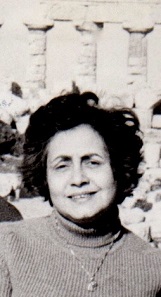by Christof Boehringer
translated by Sylvia Karges
September 8, 2016 – In very advanced years, but still unexpected, archaeologist and professor of numismatics Aldina Cutroni Tusa, doyenne in the field of Sicily, died on August 16 in Palermo. For decades her research made her a sought-after expert in regards to questions spanning from the beginning of coinage to the Byzantine era, especially of the western half of the island.
Aldina Cutroni Tusa in front of Temple C in Selinus. Photo: Family archives Tusa.
Aldina Cutroni, born 1923 in Bellizona Pozza di Gotto, not far from Milazzo, began her studies in Rome to then – war-related – continue in Messina. There, under P.E. Arias, mainly known because of his vase research (Spina), she received her university degree (“laurea”) with a thesis on problems of archaeology, topography and numismatics of two poleis in Bruttium, Terina and Temesa.
In 1947, she returned to Rome and continued her studies at the Scuola di Perfezionamento. This is also were she met her future husband, the archaeologist Vincenzo Tusa. Inspired by numismatic classes by Secondina Lorenzina Cesano, she found the area, which would determine her lifelong academic work.
But numismatics never just was an isolated field for Aldina Cutroni Tusa for she always understood it as being part of the more extensive fields of history and archaeology. In 1949, she received her university diploma in Rome having written a thesis on Laconian pottery under the etruscologist and ancient vases researcher Giulio Q. Giglioli. In the following year she got married and the young couple moved to Palermo, where her husband had won the competition of Ispettore of the Archaeological Superintendency.
Aldina Cutroni Tusa didn’t remain without work either. By Superintendent Jole Bovio Marconi, she was entrusted to open the boxes which, during the war, were stored in a secure place. In them, there was also a coin collection, which she started to reorganize and study. Even when she received a position at the Assessorato Pubblica Istruzione, she continued her work at the Coin Cabinet of the Palermo Museo Nazionale.
Its treasures, before the war only to see under great difficulties, she generously made available to researchers, who remember her tireless efforts in gratitude – not only famous researchers, but also students at the beginning of their academic career, just like the author of this text.
In the 1950s, Aldina Tusa began to publish her numerous articles – articles which were both of numismatic and archaeological content (for example about the research on Lilybaion [Marsala]), which were issued in “Annali dell’Istituto Italiano di Numismatica” and “Kokalos”, later also in “Sicilia Archeologica”, founded by her husband.
Private reasons – the couple had two children, Sebastiano, who would later chose the same profession as his parents, and Lidia, who today heads an agricultural company – led Aldina Tusa in the early 1960s to resign from her position at the museum, but without stopping her research. This is when, very slowly, numismatic became a bigger part of her academic life, but without denying the general historical-archaeological objective.
In 1971, Aldina Cutroni Tusa was appointed to teach numismatics at the Facoltà di Lettere of the Università degli Studi of Palermo. This was a position she filled with life until 1994. From this time, four students stand out, of whom Lucina Gandolfo currently is in charge of the coins of the museum and Lavinia Sole, as university lecturer, who holds the chair Aldina Cutroni Tusa once held.
If you wanted to meet her, congresses and convegni were the perfect opportunities: The professoressa Aldina Cutroni Tusa was always attending! Who wasn’t impressed by her materials she brought to light, by her interpretation which she granted to them, and by her energetic defense, when at the same time she was always aware, that only academic controversies really created a development of our knowledge.
We can look at an impressive body of work of 60 years with more than 120 titles of publications. And these concentrated more and more on the coins of western Sicily – Greek, Punic, indigenous, Roman. Having a better knowledge today about the emissions of the mints and the coin circulation of every part of the island is for the most part due to the work of Aldina Cutroni Tusa. By putting together a collection of articles, whose publication she will now not witness anymore, several scholars and researchers thank her for her work. (Lavinia Sole – Sebastiano Tusa (eds.), “NOMISMATA. Studi di numismatica offerti ad Aldina Cutroni Tusa per il suo novantatreesimo compleanno”, currently at the printer).




